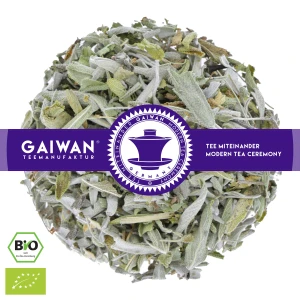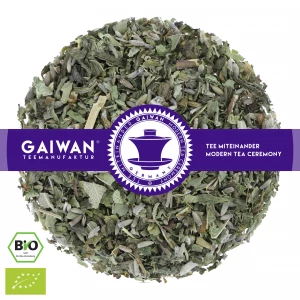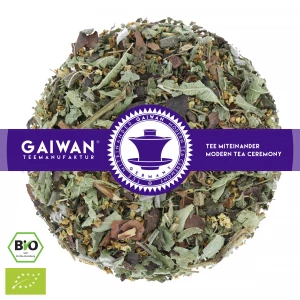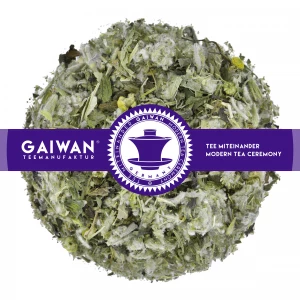Loose Tea with Sage
Sage was already firmly established in the Middle Ages as a medicinal plant for all kinds of complaints. Even Hildegard von Bingen swore by the effect of sage, either as leaves to chew or as a delicious sage tea, for acute toothache or problems with the stomach. We offer certified organic sage tea pure, as well as sage as an ingredient in delicious herbal tea blends, for example as a relaxation tea at the end of the day.
-

Out of stock
Taste: ethereal, tangy
Preparation: 4-5 teaspoons (10-15g) per 1 L (13.8 fl oz) of water (100°C | 212°F), brewing time: 4-5 minutes.
Ingredients: sage from controlled organic cultivation in Bosnia. Learn More -

Out of stock
Taste: relaxing, soft, full
Preparation: 4-5 teaspoons (10-15g) per 1 L (13.8 fl oz) of water (100°C | 212°F), brewing time: 4-5 minutes.
Ingredients from controlled organic cultivation: peppermint, ribwort plantain, lemon balm, lavender flowers, sage. Learn More -

Out of stock
Taste: soothing, soft, full
Preparation: 4-5 teaspoons (10-15g) per 1 L (13.8 fl oz) of water (100°C | 212°F), brewing time: 4-5 minutes.
Ingredients from controlled organic cultivation: elderflowers, lemon balm, cocoa shell, peppermint, sage, licorice. Learn More -

Out of stock
Taste: tangy, aromatic
Preparation: 3-5 teaspoons (10-12g) per 1 L (13.8 fl oz) of water (100°C | 212°F), brewing time: 8-10 minutes.
Ingredients from controlled organic cultivation: greek mountain Tea, sage, chamomile, lemon verbena, lemon balm, peppermint, lime blossoms, thyme. Learn More
Sage Health Benefits
Besides the potential uses mentioned above, such as toothache and stomach problems, sage is often recommended by alternative practitioners for colds and fever. In addition to essential oils, sage also contains some bitter and tannic substances, as well as antioxidants. Essential oils are often used in aromatherapies for relaxation and at the same time have disinfectant qualities. Sage tea can stimulate digestion because of the bitter substances it contains. Antioxidants, in this case the so-called flavonoids, can help protect cells from oxidative stress.
Where Does Sage Come From?
Sage originates from the Mediterranean region. In Italy and Greece, sage is widespread. However, sage is now widely used throughout Europe. One of our delicious herbal teas - Crete Herbs - combines several healthy ingredients such as sage, chamomile, , lime blossom and others. Greek mountain tea is used as the base. Treat yourself to some time out with our healthy tea compositions.




